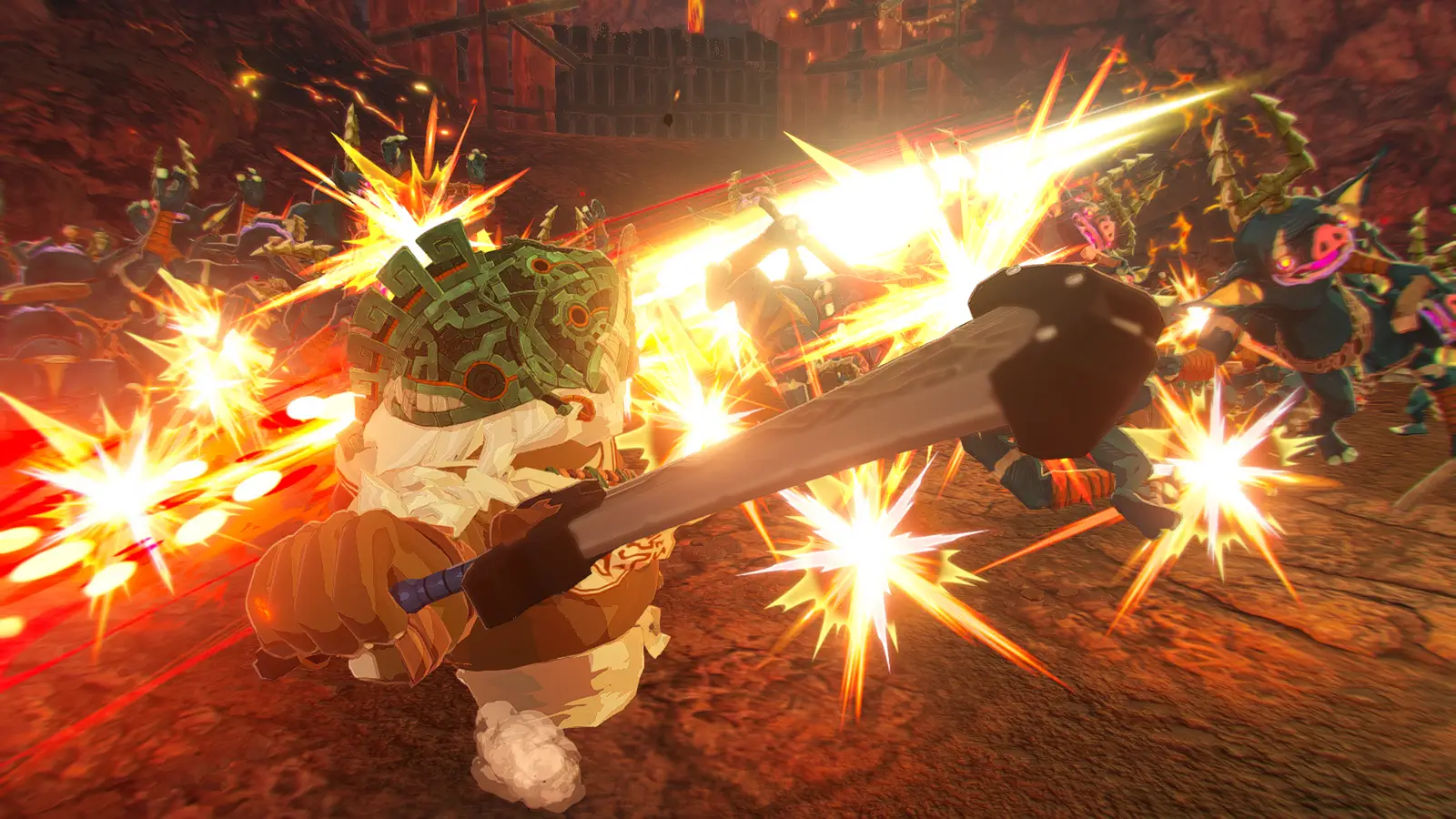Copyright Polygon

There’s a moment in The Legend of Zelda: Wind Waker that I’ve never been able to forget. Midway through the seafaring adventure, Link discovers the remains of Hyrule Castle hidden underneath the Great Sea. Inside its walls is a battle in stasis. Moblins and Darknuts are frozen in place, locked in the midst of an assault on the castle at the behest of Ganondorf. We come to discover that it was an act of divine intervention, as the gods flooded Hyrule and placed the castle in a protective, time-freezing barrier. The moment Link pulls the Master Sword within the castle from its pedestal, everything springs to life. It’s his job to finish a battle that was first fought ages ago. History matters in Zelda, and that truth is especially pronounced in Hyrule Warriors: Age of Imprisonment, out Nov. 6 for Nintendo Switch 2. Another entry in the hack-and-slash spinoff series, which weaves the Musou action of Koei Tecmo’s Dynasty Warriors games into Hyrulean lore, Age of Imprisonment is built to fill in some of the gaps left by Tears of the Kingdom’s time-traveling story. We know how the final battle between Link and Ganondorf ended in that game, but one boss fight doesn’t tell the full story of a long war that spanned generations. Every warrior mattered. Every sacrifice mattered. Every battle mattered — even if they weren’t always so exciting to fight in. Rather than telling an alternate history story, like 2020’s divisive Breath of the Wild tie-in Age of Calamity, Age of Imprisonment neatly slots into Zelda canon. It’s also actually about Zelda herself. In Tears of the Kingdom, the princess is separated from Link after a dehydrated Ganondorf is awakened in the depths below Hyrule. Zelda falls through a time warp and ends up in ancient Hyrule. Through memories that Link finds in his adventure, we know that Zelda teams up with King Rauru in the past to help imprison Ganondorf and find a way to help Link finish the job in the future. Age of Imprisonment fills in the gaps between flashbacks to paint a more complete picture of the effort that went into the Imprisoning War. Age of Imprisonment’s commitment to that historical premise is both a strength and a hurdle. It declines to fill the cast of playable characters up with faces from Tears of the Kingdom or classic characters from other games. Even Link is absent from the roster. Instead, Zelda gets a true starring role alongside period-appropriate fighters like Rauru, Mineru, and the other sages of the era. That decision gives the game a more focused direction rather than turning it into nonsensical fan service. The trade-off is that it has to invent a lot of new characters to create a sizable enough roster, to mixed success. On the positive side, we do get a fantastic new hero in Calamo, a pint-sized Korok who lends his sword to the war. He’s also joined by a mysterious Zonai construct, a silent swordbot who acts as a stand-in for Link. (It’s a comical design gag that suggests that Link is so devoid of emotion that he may as well be a robot.) The relationship between those two misfit heroes makes up the heart of a story about putting trust in your allies. Less compelling is the rest of the new characters invented to pad the roster. Forgettable Gorons like Pastos or Hylian soldiers like Quino wind up feeling like redundant bodies made to fill out a character select screen. Those bodies still put up one hell of a fight, though. Building off the excellent combat in Age of Calamity, the team at Koei Tecmo’s newly established AAA Games Studio (yes, that is the developer’s actual name) has fun imagining how the different races of Hyrule fight while cutting down hundreds of Moblins. Mineru is a standout, using Zonai tools and invoking her mech construct to deliver enormous damage. Ardi, the Gerudo sage, uses a lightning-imbued sword to slice enemies up. And Calamo’s power lies in elemental berries that he can launch to create total chaos. The B-cast’s movesets aren’t as creative, but still offer some occasional twists that make each fun to experiment with. One Gerudo warrior delivers additional damage by timing attacks just right in a mini-rhythm game. With those character kits as a foundation, Age of Imprisonment’s combat is all about stringing together moves. Attack strings chain into follow-up strikes. Perfect dodges lead to flurry rushes. Breaking down a major enemy’s shield opens the door for a weak-point strike. There are unique skills that can counter a specific flavor of boss attack. Most exciting is the addition of Sync Strikes, which allow any two characters to perform devastating tandem attacks that are unique to each pairing. (That’s the most meaningful piece of the combat considering that camaraderie is so central to the story.) With all of those offensive moves, and more, there’s never a break in the action. A successful mission has me chaining one ability into the next, executing a constant display of flashy moves. It’s Musou spectacle at its finest, and the added power of the Nintendo Switch 2 can actually support it this time with smoother performance. Age of Imprisonment adds another layer of creativity to that already strong system by integrating a unique gameplay twist from Tears of the Kingdom, though it leaves some other great ideas on the table. Players gradually get access to Zonai devices that can be equipped to a submenu alongside special attacks. Old tools like flamethrowers and hydrants become elemental weapons that interact with one another and the environment. If I drop a Frost Emitter in a puddle, it’ll freeze both the water and any enemy standing in it. Tears of the Kingdom’s signature powers are underrepresented, though. Ultrahand, which lets players build wacky devices in that game, is only adapted here in Rauru’s moveset where he can use the power to grab and repel projectiles. Weapon fusing is only namechecked in a system where characters can use monster parts in battle to deliver shield-breaking attacks. It’s a bit of a missed opportunity considering that there’s a deep RPG system underneath the action, where weapons can be leveled up and infused with perk-granting seals. Creating bizarre weapons from a glut of resources, ones earned in missions and used to unlock character upgrades, feels like the perfect twist for the Hyrule Warriors format. Limited creative thinking is a persistent problem that only weighs on the strong action the longer the story goes. Most missions have my team of warriors taking down a few captain-like enemies, like Stone Taluses and Hinoxes. Sometimes I need to grab an outpost along the way, but few of the missions feel like bespoke scenarios. A few missions send me to Tears of the Kingdom’s depths, which is little more than a dark change of scenery. Some better ones send Calamo to the sky, riding the back of his transforming robot pal for shoot-’em-up interludes. Nothing here quite reaches the narratively compelling heights of having players pilot Divine Beasts in Age of Calamity, though. I’m mostly just slashing through the same set of monsters over and over again in missions that remain at a static difficulty level throughout. Yes, that’s just the proudly repetitive nature of this breed of game, but some of Koei Tecmo’s other Warriors games have shown that there’s a lot more you can do with that premise. This year’s Dynasty Warriors: Origins features some thoughtfully designed missions that had me bouncing between different fronts to manage an evolving strategic attack from enemy forces. Some of those battles successfully get across the idea that you’re fighting a war. Age of Imprisonment struggles to capture that same feeling despite the fact that you’re reclaiming territories across Hyrule that are overrun with Ganondorf’s minions. Maybe it’s a logical bit of design considering that you’re fighting waves of shambling monsters rather than an organized army. After all, Ganondorf himself is a bit of a non-factor as a leader in the whole affair, hardly getting more depth in his brief appearances. The thrill of cutting down waves of enemies is there, but it never feels like I’m fighting a war. Age of Imprisonment is still a war story, though — one that’s meatier than its fun but flat battles suggest. We know how the fight against Ganondorf ends in Tears of the Kingdom. It’s a long wind up that leads to a lone hero taking on the big bad, as is the case in just about every Zelda game. But Tears of the Kingdom’s time travel twist allows us to understand that there’s history to that present day battle. Hyrule and its people have spent thousands of years fighting an ongoing war. Link’s adventure is just one battle in a long lineage that builds off all the victories that came before. “If we don’t have each other’s backs now, when will we?” It’s the idea that Wind Waker captured so well in that one moment that sticks with me to this day. Links stumbles into a battle frozen in time and it’s his job to finish it. It’s as if the gods are handing off the baton to him in a relay race. We have done our part in this fight, and now it’s your turn. There is a sense of an unspoken alliance built over ages, where generations strategize with one another thousands of years apart. That’s baked into the very concept of Link, a Hero of Time who is reincarnated again and again to fight a long-running war against Ganon, and other recurring foes, in all timelines. Age of Imprisonment makes good use of Zelda history to get at that idea in even more explicit terms, even when the story relies too heavily on dull lore to stitch together the unlockable memories featured in Tears of the Kingdom. At one point, our core cast of heroes strike up an alliance with a Rito warrior. They seem a little surprised that he’s so easily swayed to their side after a battle. “If we don’t have each other’s backs now, when will we?” he tells them. When will we? It’s the story’s defining moment, a reminder that our grandest battles take time and an ongoing, unified effort to win — something that anyone struggling to feel hope for the present moment should take to heart. You don’t plant a seed thinking you’ll live long enough to watch it grow. You do it so someone you’ll never meet will get to rest under a tree’s shade one day. One little Korok’s victory today could become someone else’s final boss fight tomorrow.



